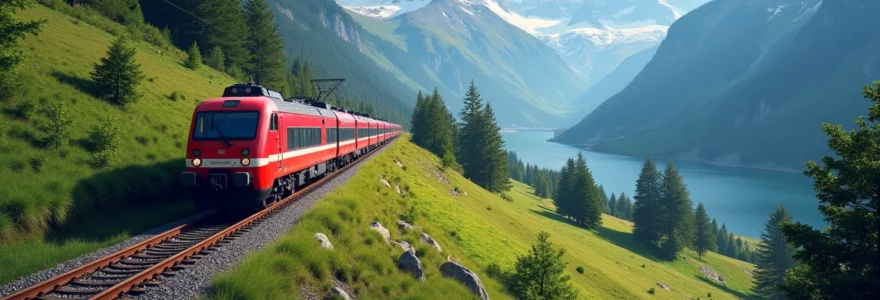Switzerland’s rail network is renowned for its breathtaking scenic routes, punctuality, and engineering marvels. Traversing the Swiss Alps by train offers an unparalleled opportunity to witness stunning vistas of snow-capped peaks, pristine lakes, and charming villages. This mode of travel not only provides a comfortable and efficient way to explore the country but also showcases Switzerland’s commitment to sustainable tourism and innovative transportation solutions.
Swiss rail network: engineering marvels and route planning
The Swiss rail system is a testament to human ingenuity and precision engineering. Overcoming the challenges posed by the country’s mountainous terrain, Swiss engineers have created a network that seamlessly connects even the most remote alpine regions. This intricate web of railways is not just functional; it’s a work of art that harmoniously blends with the natural landscape.
Gotthard base tunnel: world’s longest railway tunnel
At the heart of Switzerland’s rail innovation lies the Gotthard Base Tunnel, a feat of modern engineering. Stretching 57 kilometers beneath the Swiss Alps, this tunnel is the longest and deepest railway tunnel in the world. Its completion in 2016 marked a new era in European rail travel, significantly reducing journey times between northern and southern Switzerland.
The tunnel’s construction required overcoming numerous geological challenges, including varying rock types and high temperatures. Engineers employed advanced boring machines and implemented innovative cooling systems to make this ambitious project a reality. Today, the Gotthard Base Tunnel serves as a critical link in the European rail network, facilitating faster and more efficient transportation of both passengers and goods.
Albula railway: UNESCO world heritage engineering
The Albula Railway, part of the Rhaetian Railway in the Albula/Bernina Landscapes, is a UNESCO World Heritage site that showcases the pinnacle of 19th-century railway engineering. This narrow-gauge railway winds through the Swiss Alps, featuring an impressive array of spiral tunnels, viaducts, and bridges that seamlessly integrate with the surrounding landscape.
One of the most iconic structures along this route is the Landwasser Viaduct, a curved limestone bridge that spans 65 meters high over the Landwasser River. The viaduct’s elegant design and the way it blends with the rugged alpine terrain exemplify the Swiss approach to railway construction – a perfect balance of form and function.
SBB mobile app: real-time train tracking and itinerary optimization
In the digital age, Switzerland’s commitment to railway excellence extends beyond physical infrastructure to cutting-edge technology. The SBB Mobile app, developed by Swiss Federal Railways, is a prime example of how modern technology enhances the travel experience. This comprehensive tool provides real-time train tracking, allowing passengers to plan their journeys with precision.
The app offers features such as personalized timetables, platform information, and delay notifications. It also integrates with other modes of public transport, enabling seamless multi-modal travel planning. For tourists, the app is an invaluable resource, offering suggestions for scenic routes and providing information about attractions along the way.
Panoramic routes: switzerland’s most scenic train journeys
While the entire Swiss rail network offers picturesque views, certain routes stand out for their exceptional beauty and are designed specifically to showcase the country’s diverse landscapes. These panoramic routes have become attractions in themselves, drawing travelers from around the world who seek to experience the majesty of the Swiss Alps from the comfort of a train carriage.
Glacier express: st. moritz to zermatt alpine traverse
Often dubbed the “slowest express train in the world,” the Glacier Express is a journey that exemplifies the adage “it’s not the destination, it’s the journey.” This iconic route connects two of Switzerland’s most famous mountain resorts, St. Moritz and Zermatt, traversing 291 bridges and 91 tunnels along its 8-hour journey.
Passengers on the Glacier Express are treated to an ever-changing tableau of alpine scenery. The train climbs the Oberalp Pass at 2,033 meters above sea level, offering sweeping views of glaciers, pristine mountain lakes, and remote valleys. The journey also includes passage through the dramatic Rhine Gorge, often referred to as the “Swiss Grand Canyon.”
The Glacier Express is not merely a means of transport; it’s a moving panorama that encapsulates the essence of Switzerland’s natural beauty.
Bernina express: chur to tirano cross-border experience
The Bernina Express offers a unique cross-border journey from Chur, Switzerland, to Tirano, Italy. This UNESCO World Heritage route is a masterpiece of railway engineering, featuring 55 tunnels and 196 bridges. The train climbs to the Bernina Pass at 2,253 meters, making it the highest railway crossing in Europe without the use of cogwheels.
One of the most spectacular segments of this journey is the passage over the Brusio Spiral Viaduct. This architectural marvel allows the train to gain altitude quickly by completing a 360-degree turn. The contrast in landscapes is striking, from the glaciers of the Bernina Range to the palm trees of Italy’s Valtellina region, all visible in a single day’s journey.
Golden pass line: lucerne to montreux landscape diversity
The Golden Pass Line offers a comprehensive cross-section of Swiss landscapes, connecting the German-speaking region of central Switzerland with the French-speaking Vaud Riviera. This journey takes passengers from Lucerne, with its medieval charm and turquoise lake, through the Bernese Oberland’s dramatic mountain scenery, and finally to Montreux on the shores of Lake Geneva.
A highlight of this route is the passage through Gstaad, a glamorous alpine resort town known for its luxury hotels and high-end boutiques. The train then descends through the Lavaux vineyards, a UNESCO World Heritage site, offering panoramic views of Lake Geneva and the French Alps beyond.
Jungfrau railway: cogwheel ascent to europe’s highest station
The Jungfrau Railway is an engineering marvel that takes passengers on a vertical journey to the “Top of Europe.” This cogwheel railway climbs to the Jungfraujoch station at 3,454 meters above sea level, making it the highest railway station in Europe.
The journey begins in Kleine Scheidegg and passes through a 7-kilometer tunnel bored through the Eiger and Mönch mountains. At the summit, passengers can visit the Ice Palace, carved into the heart of the glacier, and enjoy panoramic views of the Aletsch Glacier, the longest ice stream in the Alps.
Swiss travel pass: maximizing rail journey efficiency
For travelers looking to explore Switzerland extensively by rail, the Swiss Travel Pass offers an unparalleled combination of convenience and value. This all-in-one ticket provides unlimited access to the country’s public transportation network, including trains, buses, and boats, as well as additional benefits that enhance the overall travel experience.
Intermodal transport integration: trains, boats, and cable cars
The Swiss Travel Pass exemplifies Switzerland’s commitment to integrated public transport. It covers not only train travel but also provides access to an extensive network of buses and boats. This intermodal approach allows travelers to seamlessly combine different forms of transportation, creating flexible and scenic itineraries.
One of the most appealing aspects of the pass is its inclusion of many mountain cable cars and funiculars. This feature enables visitors to easily access high-altitude viewpoints and attractions without incurring additional costs. For example, the pass covers the scenic boat ride on Lake Lucerne and the cogwheel train up Mount Rigi, offering a diverse range of travel experiences.
Museum access: 500+ cultural institutions included
Beyond transportation, the Swiss Travel Pass serves as a cultural passport, granting free entry to over 500 museums and exhibitions across the country. This feature transforms travel days into opportunities for cultural enrichment, allowing visitors to explore Switzerland’s rich history and artistic heritage.
From world-renowned institutions like the Swiss National Museum in Zurich to smaller, specialized museums in remote alpine villages, the pass opens doors to a wealth of cultural experiences. This integration of transportation and cultural access encourages a deeper, more immersive exploration of Swiss heritage.
Seat reservation systems: panoramic carriage booking strategies
While the Swiss Travel Pass covers the base fare for most train journeys, including the scenic routes, seat reservations for panoramic carriages on premium services like the Glacier Express or Bernina Express require an additional fee. Understanding the seat reservation system is crucial for maximizing the scenic potential of these journeys.
For popular routes, especially during peak seasons, it’s advisable to book panoramic carriage seats well in advance. These carriages offer larger windows and often include audio guides, enhancing the overall experience. Some tips for securing the best views include:
- Opting for seats on the side of the train facing the valley on mountain ascents
- Choosing seats away from the middle of the carriage to avoid wheel noise
- Considering the direction of travel and sun position for optimal photography conditions
Sustainable tourism: swiss railways’ environmental initiatives
Switzerland’s railway system is not only a marvel of engineering and a gateway to stunning landscapes; it’s also at the forefront of sustainable tourism. The Swiss Federal Railways (SBB) has implemented numerous initiatives to reduce its environmental impact and promote eco-friendly travel.
Hydroelectric power: renewable energy for rail operations
One of the most significant environmental achievements of the Swiss railway system is its extensive use of hydroelectric power. Switzerland’s abundant water resources and mountainous terrain provide ideal conditions for hydroelectric generation, and the SBB has capitalized on this natural advantage.
Currently, over 90% of the electricity used to power Swiss trains comes from hydroelectric sources. This reliance on renewable energy significantly reduces the carbon footprint of rail travel in Switzerland, making it one of the most environmentally friendly ways to explore the country.
Waste reduction: on-board recycling and biodegradable catering
The SBB has implemented comprehensive waste management strategies to minimize the environmental impact of its operations. On-board recycling programs encourage passengers to separate their waste, with clearly marked bins for different materials. This initiative has significantly increased recycling rates and reduced the amount of waste sent to landfills.
In addition to recycling efforts, the catering services on Swiss trains have transitioned to using biodegradable materials whenever possible. From coffee cups to food packaging, these eco-friendly alternatives help reduce plastic waste and promote a more sustainable approach to on-board dining.
Carbon offsetting: SBB’s Climate-Neutral travel options
For environmentally conscious travelers, the SBB offers carbon offsetting options. Passengers can voluntarily contribute to projects that reduce or remove greenhouse gases from the atmosphere, effectively neutralizing the carbon footprint of their journey.
These offsetting programs support a range of initiatives, from reforestation projects to investments in renewable energy technologies. By participating in these programs, travelers can enjoy the scenic beauty of Switzerland while actively contributing to global climate protection efforts.
Culinary experiences: gastronomic journeys by rail
Swiss train journeys offer more than just visual delights; they provide a unique platform for culinary exploration. Several specialized train routes cater to food enthusiasts, combining scenic travel with gastronomic adventures that showcase Switzerland’s rich culinary heritage.
Chocolate train: montreux to broc gourmet expedition
The Chocolate Train is a delectable journey that takes passengers from Montreux to the Cailler-Nestlé chocolate factory in Broc. This vintage Belle Époque Pullman car offers a luxurious setting for a day of chocolate indulgence.
The journey begins with coffee and chocolate croissants served on board, setting the tone for the day. Upon arrival in Gruyères, passengers visit a cheese factory to learn about the production of the famous Gruyère cheese. The highlight of the trip is the visit to the Cailler-Nestlé factory, where visitors can explore the history of Swiss chocolate making and, of course, sample a wide variety of chocolates.
Cheese train: fondue and raclette tasting on le transjurassien
For cheese aficionados, the Cheese Train offers an immersive experience into the world of Swiss dairy products. Operating in winter months, this journey takes passengers through the scenic Jura Mountains while they enjoy traditional Swiss cheese dishes.
On board, travelers can savor a hearty fondue meal while admiring the snow-covered landscapes. The train makes stops at various cheese-making facilities, allowing passengers to witness the production process and taste different regional varieties. The journey culminates with a demonstration and tasting of raclette, another iconic Swiss cheese dish.
Wine railways: lavaux express and train des vignes routes
Switzerland’s wine regions are often overlooked by international visitors, but specialized wine trains offer a unique way to explore this aspect of Swiss culture. The Lavaux Express, a tourist train rather than a conventional railway, winds through the UNESCO-listed Lavaux vineyards overlooking Lake Geneva.
Similarly, the Train des Vignes connects Vevey to Puidoux-Chexbres, traversing the stunning Lavaux wine region. These journeys typically include stops at local wineries for tastings and offer breathtaking views of the terraced vineyards cascading down to the lake.
These culinary train experiences not only tantalize the taste buds but also provide insight into Switzerland’s diverse gastronomic traditions and the importance of regional specialties in Swiss culture.
As you plan your Swiss rail adventure, consider incorporating these specialized culinary routes to add a flavorful dimension to your journey. Whether you’re savoring chocolate with alpine views or enjoying cheese fondue while traversing snowy landscapes, these experiences offer a unique way to engage with Swiss culture through its cuisine.
In conclusion, train journeys through Switzerland offer an unparalleled combination of scenic beauty, engineering marvels, and cultural experiences. From the panoramic routes showcasing the country’s diverse landscapes to the sustainable practices and culinary adventures, Swiss railways provide a comprehensive and enriching way to explore this alpine nation. As you embark on your Swiss rail journey, you’ll not only witness breathtaking vistas but also participate in a mode of travel that respects and celebrates the natural environment it traverses.


